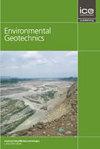Dry shrinkage cracking and permeability of biopolymer-modified clay under dry-wet cycles
IF 2.2
4区 工程技术
Q3 ENGINEERING, GEOLOGICAL
引用次数: 0
Abstract
Biopolymers efficiently improve the anti-seepage function of compacted clay layers, but research concerning the permeability stability of biopolymer-modified clay during cyclic wetting and drying is scarce. In this paper, the macro–microstructures and the permeability coefficients of biopolymer-modified clay and conventional bentonite-modified clay under dry–wet cycles are comparatively studied. The bentonite modifier is found to increase macro–microscopic cracks under dry–wet cycles, while the xanthan modifier decreases the macro–microscopic fracture rate of the clay. The physical properties of 2% by dry weight xanthan-modified clay are similar to those of 10% by dry weight bentonite-modified clay, but the permeability coefficient of the former is lower by approximately one order of magnitude. After the dry–wet cycles, xanthan-modified clay performed better in leakage prevention than bentonite-modified clay. For low-liquid-limit clay, the recommended mass percentage of xanthan gum was 1.5% considering the seepage resistance safety during dry–wet cycles.干湿循环作用下生物聚合物改性粘土的干缩开裂与渗透性
生物聚合物有效地提高了压实粘土层的防渗性能,但对生物聚合物改性粘土在干湿循环过程中的渗透稳定性研究较少。比较研究了生物聚合物改性粘土和常规膨润土改性粘土在干湿循环作用下的宏观微观结构和渗透系数。干湿循环作用下,膨润土改性剂增大了粘土的宏观裂纹,黄原胶改性剂减小了粘土的宏观断裂率。干重2%的黄原胶改性粘土的物理性能与干重10%的膨润土改性粘土相似,但前者的渗透系数要低约一个数量级。干湿循环后,黄原胶改性粘土的防漏性能优于膨润土改性粘土。对于低液限粘土,考虑到干湿循环的抗渗安全性,建议黄原胶的质量分数为1.5%。
本文章由计算机程序翻译,如有差异,请以英文原文为准。
求助全文
约1分钟内获得全文
求助全文
来源期刊

Environmental geotechnics
Environmental Science-Water Science and Technology
CiteScore
6.20
自引率
18.20%
发文量
53
期刊介绍:
In 21st century living, engineers and researchers need to deal with growing problems related to climate change, oil and water storage, handling, storage and disposal of toxic and hazardous wastes, remediation of contaminated sites, sustainable development and energy derived from the ground.
Environmental Geotechnics aims to disseminate knowledge and provides a fresh perspective regarding the basic concepts, theory, techniques and field applicability of innovative testing and analysis methodologies and engineering practices in geoenvironmental engineering.
The journal''s Editor in Chief is a Member of the Committee on Publication Ethics.
All relevant papers are carefully considered, vetted by a distinguished team of international experts and rapidly published. Full research papers, short communications and comprehensive review articles are published under the following broad subject categories:
geochemistry and geohydrology,
soil and rock physics, biological processes in soil, soil-atmosphere interaction,
electrical, electromagnetic and thermal characteristics of porous media,
waste management, utilization of wastes, multiphase science, landslide wasting,
soil and water conservation,
sensor development and applications,
the impact of climatic changes on geoenvironmental, geothermal/ground-source energy, carbon sequestration, oil and gas extraction techniques,
uncertainty, reliability and risk, monitoring and forensic geotechnics.
 求助内容:
求助内容: 应助结果提醒方式:
应助结果提醒方式:


